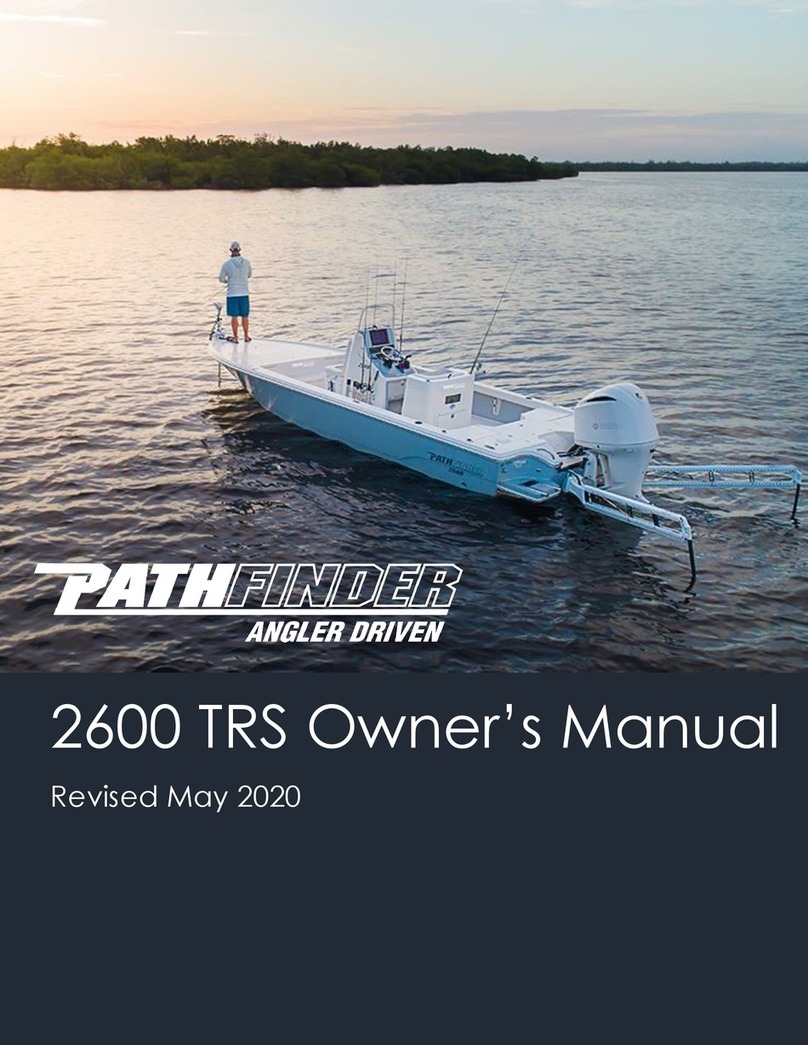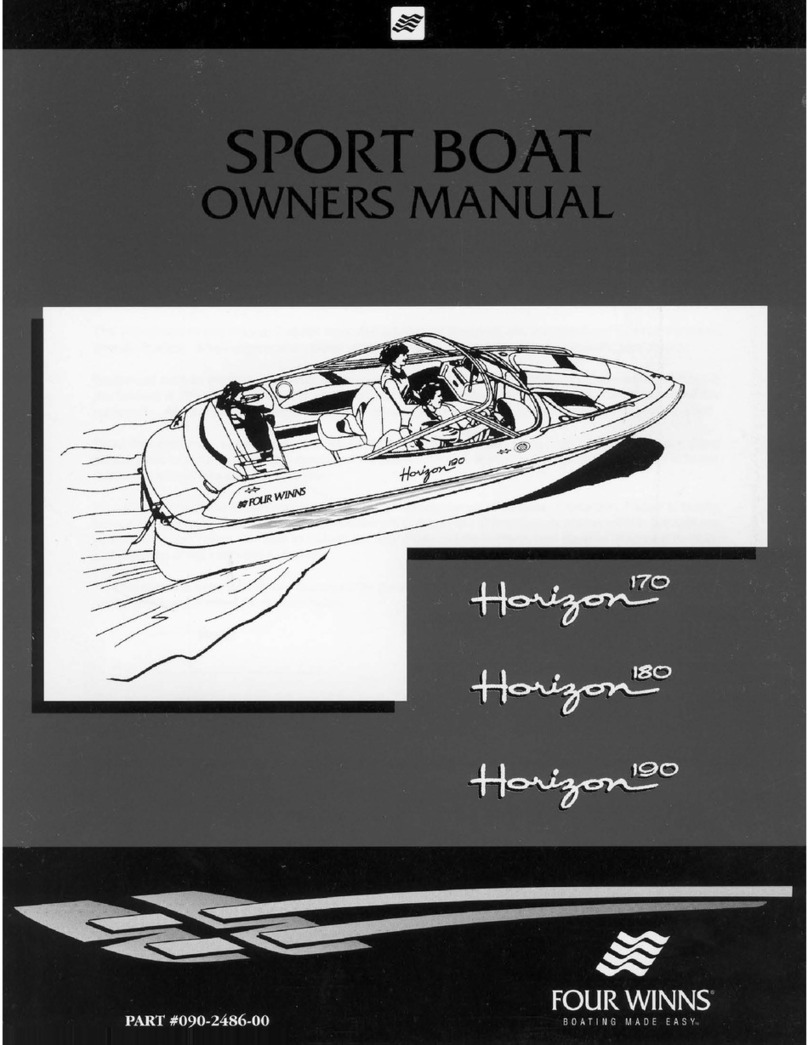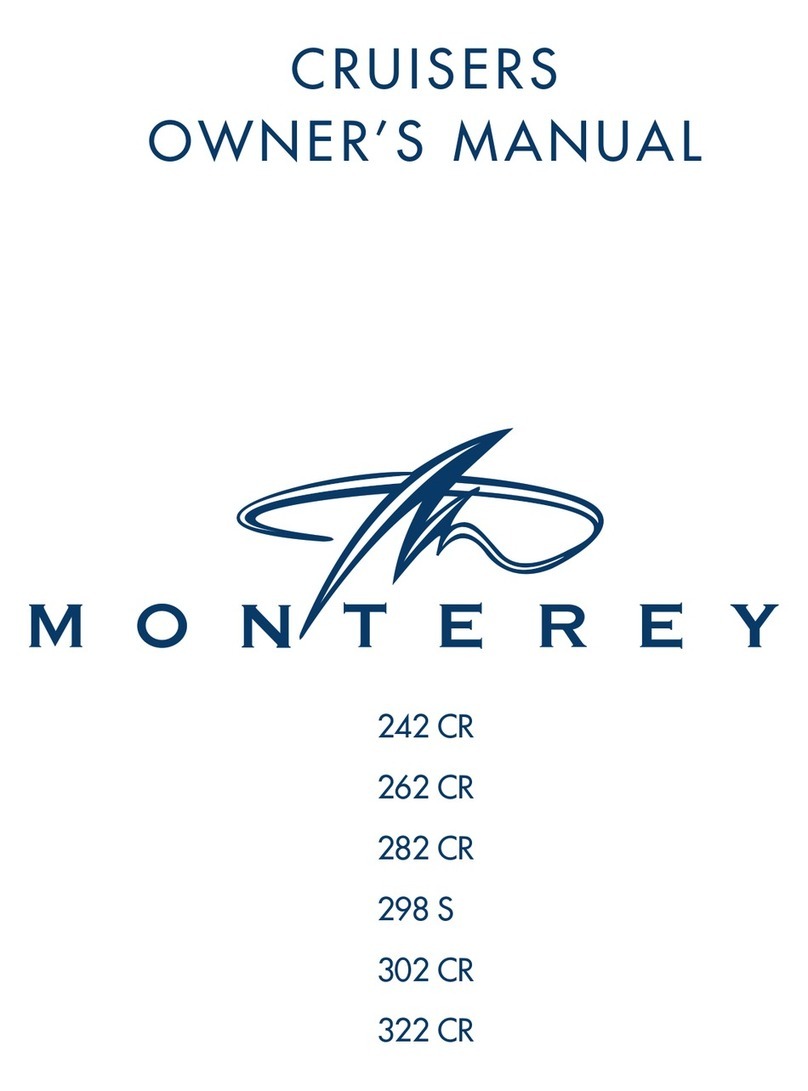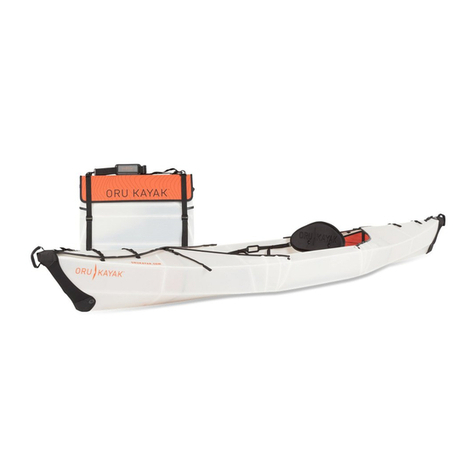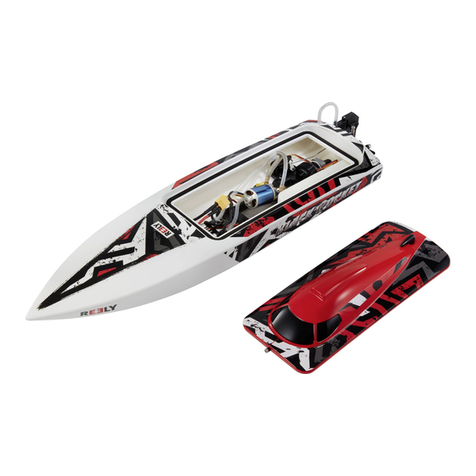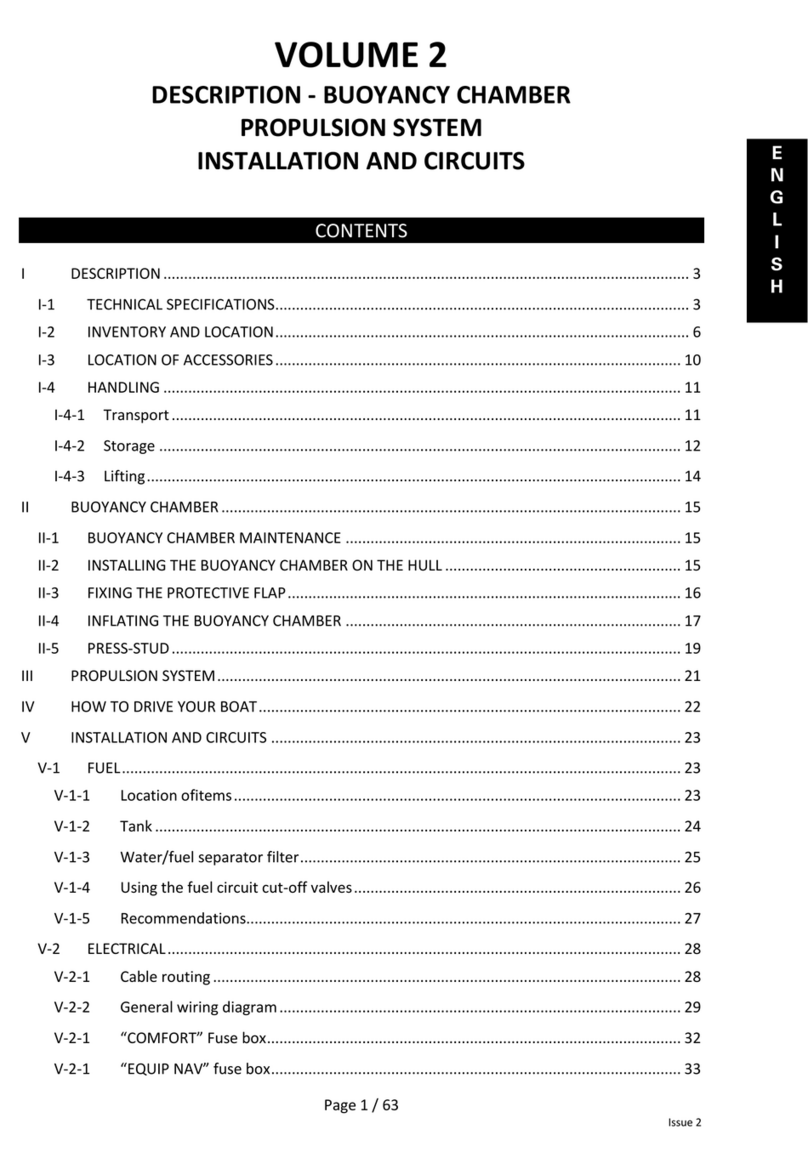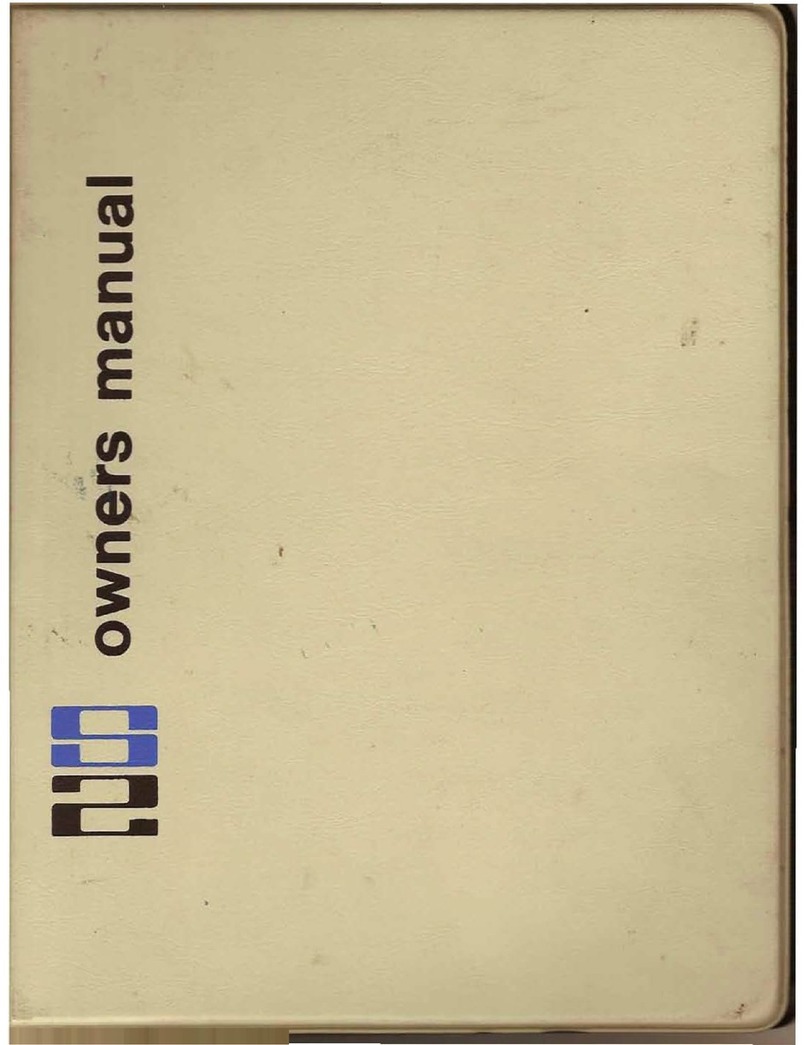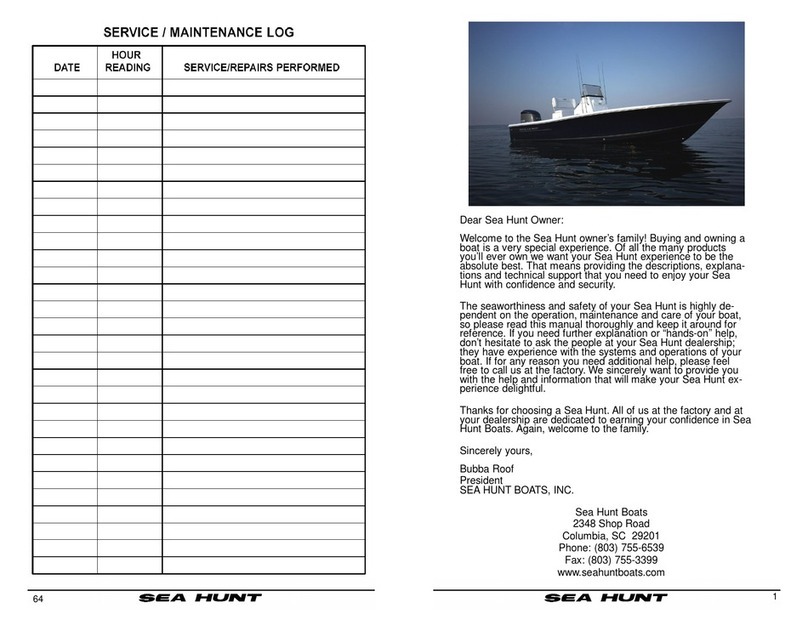Clipper Marine Corp. CM 1/4 ton User manual

CLIPPER MARINE
OWNERS
MANUAL
Models: CM21 – CM23 – CM26 – CM30 – CM32 & CM 1/4-ton
Clipper Marine Corp.
1919 East Occidental St. • P.O. Box 15063
Santa Ana, California 92705
714-835-9316

CLIPPER MARINE OWNERS MANUAL
Clipper Marine Corp.
1919 East Occidental St.
P.O. Box 15063
Santa Ana, California 92705
714-835-9316
July 1975
Dear Clipper Owner:
We are happy you have chosen to join ,one of the fastest growing fleets in the country today.
We hope you will take an active part in your local Clipper Association and enjoy many years
of happy sailing in your new Clipper.
In the following pages we will attempt to familiarize you with the many features of your new
Clipper, suggest ways of protecting your investment and supply some basic sailing tips to
help you get started on the right track.
We trust you will find this manual helpful, whether your Clipper is a fixed keel, swing keel, or
any one of the models from 21 to 32 feet.
Happy Sailing,
Clipper Marine Corporation

Clipper Marine Corp.
1919 East Occidental St.
P.O. Box 15063
Santa Ana, California 92705
714-835-9316
Dear Owner:
We at Clipper want you to be completely satisfied with your sailboat that you have recently
purchased. Your dealer has prepared and looked after the launching and commissioning of
your boat to make certain that the boat is in fine working order. After a few initial shake-down
cruises and sea trials, there may be some questions about your Clipper sailboat that the
Owners Manual cannot answer. These problems can best be answered by your local dealer,
and he will be more than happy to assist you in solving the problem. If you still do not get
complete satisfaction from your dealer, please call me at (714) 835-9316 and tell me about
them. I will do my best to answer your questions and provide you with alternative answers.
Happy Sailing,
Phil Kaufman
CLIPPER MARINE CORPORATION

CONTENTS
SECTION DESCRIPTION
I History & Introduction of Clipper Marine Corporation
II Warranty Policy Manual
III Spars & Rigging
IV Sails: Care & Maintenance Bending on & Hoisting
V Electrical System & Navigational Lights
VI Head and Ice Box
VII Plumbing Systems
VIII Pedestal Steering
IX Your Trailer & Trailering
X Keels and Rudders
XI Outboard Engines
XII Inboard Engines
XIII Safe Fueling Practices
XIV Launching & Retrieving
XV Fiberglass Maintenance & Care
XVI Exterior Teak Trim
XVII Safety Equipment
XVIII Basic Sailing
Appendix
Sail Specifications
Yanmar Diesel Engine Specifications
Stanchion Specifications
Rigging, Sheets, & Halyard Specifications
This manual was reproduced by Calovini Photo/Graphic Design for the sole purpose of free distribution to owners or
future owners of Clipper Marine sail boats and may not to be sold in its present form or reproduced in its present form
for resale purposes. Any questions may be directed to Calovini Photo/Graphic Design at either calovini@calovini.com
or by phone at 614-895-3645.

SECTION ONE
HISTORY AND INTRODUCTION OF CLIPPER MARINE CORPORATION
The essence of a good boat is design. William I. B. Crealock, N.A., has spaced no effort in his
Clipper designs, as they are well balanced and exceptionally stiff. Each swing keel Clipper 21
through 26 is designed so the keel lifts up into the hull keel trunk while in the up position. This
means she is much easier to launch and retrieve, and on the highway, she’s much easier to trail
since the Clipper is so much lower on the trailer. To raise and lower the mast, only three stays need
to be disconnected (in the case of the 23, 26 and 30) and only one stay in the case of the 21 (cov-
ered in detail in rigging Section Three).
Every Clipper is built of all hand layed fiberglass and conforms to the most stringent standards.
Layer after layer of mat, cloth and woven roving are added until a rigid hull and deck are obtained.
Maintenance is at a minimum with your new Clipper. (Some tips are covered in Section Fifteen on
Fiberglass Maintenance and Care.)
Clipper Marine was started in 1969. The original factory was located in San Clemente, but the facil-
ity was quickly outgrown as the demand for Clipper 21’s was overwhelming almost from the first day
of production. The plant was moved to its current location in Santa Ana, where several new models
have been continuously added to the already fine line of sailboats.
In addition to the regular swing keel models, all Clippers, 23 feet and larger are available in a fixed
keel version.

SECTION TWO
WARRANTY POLICY MANUAL
Dealer must make available to all purchasers and potential purchasers, prior to sale, Clipper
Marine’s current warranty and, upon sale, must obtain purchaser’s signature on Clipper Marine’s cur-
rent warranty registration card, and provide purchasers with a copy of the warranty and the change
of address/change of owner form. Dealer must return the completed and signed warranty registra-
tion card to Clipper Marine within 10 days from date of sale.
Whenever a warranty claim is made by any Clipper Marine boat owner, Dealer must call Clipper
Marine at (714) 835-9316 to obtain approval for the necessary repairs from the manager of Clipper
Marine’s Products Service Department or his supervisors. If the warranty work is approved during
this telephone conversation, Dealer will be assigned a repair number for the work, which number
must be used by Dealer in all further correspondence relating to that claim. Upon completion of the
warranty repair work, Dealer shall fill out the Clipper Marine Warranty Claim Report and shall trans-
mit that report, fully completed and signed by the boat owner, along with all bills and repair receipts
for material and labor. Such warranty claim reports must be submitted to Clipper Marine within
30/days after the completion of the repairs. NO WARRANTY CLAIMS WILL BE HONORED
UNLESS DEALER FULLY COMPLIED WITH THE FOREGOING REQUIREMENTS.
Please note the following regulations before beginning warranty repair work. Clipper Marine’s war-
ranty applies only to defects discovered within one year from date of first sale or use by dealer,
whichever occurs first. The warranty does not apply to any boat used for charter service or any
other commercial use (or to any boat which has been materially altered or modified without Clipper
Marine’s consent). The warranty applies only to boats which have been given normal and reason-
able maintenance and does not apply if the repair is required because the boat has been subjected
to abnormal or unreasonable use. The Clipper Marine warranty does not cover normal wear and
discoloration of finishes, fittings or fabrics. (Leaks around windows and pop-tops are considered nor-
mal and subject to normal maintenance.) Clipper Marine will not reimburse Dealer for any material
used in warranty repair work unless Clipper Marine is first given the opportunity to supply the neces-
sary materials to Dealer, free of charge.
Clipper Marine may require Dealer to return the boat to Clipper Marine’s factory in order to effect
major repairs.
Clipper Marine expects its dealers to stand behind their warranty work, and will not reimburse Dealer
for the same repair twice.
We feel that if Clipper Marine’s dealers handle all warranty claims as though they were bearing the
expense, the Clipper Marine warranty policy will operate smoothly and to the benefit of Clipper
Marine, its dealers and their customers. Clipper Marine asks each dealer to keep the Clipper Marine
warranty policy manual in front of him when talking to Clipper Marine owners about warranty cover-
age.

SECTION THREE
SPARS AND RIGGING
The rigging on your Clipper is of the highest quality stainless steel with swedged fittings. The stand-
ing rigging consists of a headstay, backstay, two upper shrouds and four lower shrouds (two lower
shrouds in the case of the Clipper 21). To raise and lower the mast, the forward lowers and the
headstay need only be disconnected. The remainder may be left connected for trailering, saving
time at your next stop.
The running rigging consists of two halyards, a main and a jib halyard for hoisting the sails. To sim-
plify setting up your boat to sail, leave the halyards tied to their respective cleats at the base of the
mast so they don’t become tangled.
MAINSHEET: The line from the mainsheet jam cleat and the block is
fastened to the lower side of the boom. The mainsheet jam cleat
fastens to the traveler in the cockpit. The traveler may remain
centered by use of the traveler control lines, while you are first
getting use to your new Clipper. After you have become proficient in handling your Clipper and you
feel like experimenting to gain more speed, you may start working with the traveler. Starting from
the centered position you will gradually pull the traveler to windward (toward the direction the wind is
coming from) in fairly light winds—say up to 8 or 10 knots. The 10 to 12 knot wind zone you will
probably find optimum performance with the traveler centered, but as the wind increases you can let
the traveler slide down to the leeward side.
JIB SHEETS: Attached to the clew (grommet at the lower trailing edge of the jib sail) and runs out-
side of all shrouds and lifelines and through the jib sheet blocks. Your halyards and sheets should
be checked also for broken or frayed sections. Your sheets and running rigging are dacron and
occasionally an end may fray. Put a piece of tape around the line several inches back from the
frayed section and trim with a sharp knife. Use a candle or lighter to burn the end. When the dacron
melts, it will never fray again.
SPARS: Your spar (mast) is of the highest quality anodized aluminum and requires no painting.
Soap and water on the shrouds and mast along with a bronze wool pad will remove the surface dirt
and oxidation. A good automotive past wax can help keep your spar looking like new for quite some
time, otherwise eventually the surface will begin to break down and oxidize. Keeping the halyards
tied away from the mast at rest will not only eliminate a lot of noise, but it will also keep the anodized
surface from becoming marred.
It is a good idea to periodically check all nuts, bolts, cotter pins, sheaves and rivets on your mast for
signs of wear. Make sure the spreader tips are well taped to protect against sail wear. All blocks,
turnbuckles and sheaves should be lubricated periodically with a light oil or grease such as WD-40.
STEPPING YOUR MAST:
1. Hook up upper shrouds, aft lower shrouds and backstay. On the 21, hook up only the uppers, low-
ers and backstay.
2. Set mast in mast carrier and secure the base of the mast in the mast step with the bolt provided.
Note: If your mast carrier has two height positions be sure it is as high as it will go.
3. Check all shrouds to see they aren’t caught or tangled.

4. Standing in the cockpit or on cabin top, (pop-top down and hatch closed) walk the mast up and
have someone secure the headstay. Don’t let go of the mast if you go forward to attach the head-
stay.
5. Tighten lock nuts on turnbuckles. Depending on the type of turnbuckles on your Clipper, they
should have either cotter pins in place, lock nuts tightened, or even be safety wired. If not, the turn-
buckles can easily come loose, causing you to lose a mast overboard.
TUNING YOUR RIGGING: It is recommended that a qualified person be on hand while the rig on
your new Clipper is tuned for the first time. Later you may follow these steps in tuning your rig and
you will be surprised at the improvement in performance that will be made. Caution: Do not over-
tighten the standing rigging on your Clipper. It should no sound like a guitar string!
First with your boat sitting at the dock:
1. The headstay and backstay should be tightened equally. Of all the rigging on your Clipper, the
headstay and backstay should be the tightest. This is so that the headstay will not sag excessively
while you are sailing to weather under jib or genoa. The sailmaker has allowed for about 10” of sag
in your jib so any more than this under load is reducing your performance. A simple test of headstay
tension is to stand on the foredeck and tug on the headstay. With a good strong, short tug, you
should be able to flex the headstay five or six inches.
2. Next, tighten up the shrouds. Both sides should be tightened equally. Both turnbuckles should
have an equal number of turns, and should be good and snug, but not as tight as the headstay.
3. Now tighten all of the lower shrouds equally. These will not be as tight as the uppers, but just to
the point where the mast is in column or straight. To determine this, sight up the sail groove in the
aft edge of the mast. It should be in a perfectly straight line, both laterally and fore and aft.
4. If the mast is not in column, re-adjust the upper and lower shrouds until you have the mast in a
straight position.
5. Now you are ready to perform the fine tuning under sail. In a breeze of 8 to 12 knots, take the
boat out and alternately sail on one tack and then the other. Sight up the mast and see if it is still in
column. If not, tack and adjust the turnbuckles when they are not under load. If you have adequate
headstay tension to prevent excessive sag while under sail, you should never have to touch the
headstay or backstay to get the mast in column. All adjustments will be made to the upper and
lower shrouds. You may have to repeat this operation for five or six tacks until the mast looks per-
fectly straight. Now pin or tighten the safety nuts on your turnbuckles.
After you have sailed several hours in some stronger winds, you will notice that the shrouds have
stretched. This is perfectly normal the first few times, and it will he necessary to re-tune your rig if
you wish to obtain optimum performance from your Clipper.
ADJUSTABLE BACKSTAY: On some Clippers an adjustable backstay is supplied. It is primarily
used for racing. This can be tightened prior to a race to minimize headstay sag, but should be
slacked off after you return to the dock. If you find your self in exceptionally strong winds, it is a
good idea to increase the tension on the backstay a little with the adjuster. This will keep the mast in
compression and may prevent a rigging failure. The primary reason for rigging failure in heavy wind
conditions is too much sail and too little backstay tension.

SECTION FOUR
SAILS: CARE AND MAINTENANCE, BENDING ON AND HOISTING
Your new Clipper has come equipped with a set of working sails (a main and jib). If this is your first
boat and you are just learning to sail, the main and jib sails will be all that you will need, but as you
become more proficient, you will probably want to add more sails. Optional sails that are available to
you from Clipper Marine include a spinnaker and a 150% genoa and reacher/drifter. If you add
these you will be equipped to sail in just about any conditions.
JIBS AND GENOAS: So that you will understand the difference in genoa sizes, the percentage indi-
cated an a genoa refers to the longest perpendicular (LP) of the sail. This is the distance along an
imaginary line running from the clew of the sail and intersecting the luff of the sail at a right angle.
In the case of Clipper’s 150% genoa, the distance is 150% of the J dimension (horizontal distance
from the front side of the mast at the deck and centerline to the headstay).
SPINNAKERS: The Clipper spinnaker is of nylon and the kit includes a spinnaker pole, topping lift,
halyard, sheets, foreguy, cleats and blocks.
HOISTING SAILS: You are now ready to begin bending on or attaching the sails.
1. The boat should be moved around the dock until the bow of the boat is pointing as close into the
oncoming wind as possible. There is nothing as unpleasant or frustrating as trying to hoist sails with
a cross wind or the wind behind you.
2. Starting with the mainsail, insert the battens in the four pockets, being careful the ends are tucked
in snugly. The mainsail should be put on the boom before attempting to hoist it, and the gooseneck
fitting (fitting on the boom closest to the mast) should be attached to the mast. The outhaul should
be tightened just enough to take cut the wrinkles in the foot (bottom edge of sail).
3. Now you are ready to hank on or attach the jib. Starting with the tack, shackle it to the first hole
behind the headstay. Working from the tack upward, attach each hank to the headstay, making sure
the sail doesn’t get twisted. The jib sheets should now be run aft through their respective blocks and
the halyard attached.
You are now ready to hoist sails: Beginning with the main, hoist the sail so the top or head just
clears the backstay. Now apply downward pressure on the boom at the gooseneck to just remove
the wrinkles from the luff (leading edge of sail). The gooseneck on the boom should now be below
the opening in the mast which accepts the gooseneck. Tie the down haul line off on the cleat provid-
ed.
HOIST_THE JIB: When the jib is hoisted it will probably need additional tension to remove the scal-
lops from between the hanks. You don’t want the hoist too tight, but just enough to completely
remove these scallops (sags in the sail between hanks). As the wind velocity increases you may
note the scallops begin to/reappear, in which case, apply additional tension. The necessary tension
will either require a small winch on the mast or a simple trucker’s hitch. (With the sail hoisted to the
top, tie a loop in the rope section of the halyard two feet above the cleat. Take the remaining halyard
down around the cleat, up through the loop and then tie off to the cleat.) You are now ready to
adjust the jib sheet lead positions.
Generally speaking, the working jib will lead to the forward end of the track and the genoa to the aft
part of the track. For optimum performance, the position of the fairlead is best determined by

sheeting the sail in and sailing up into the wind until the sail just begins to luff or break. If your lead
is in the correct position, the entire luff of the sail from head to foot luffs or breaks at the same time.
If the bottom area luffs before the top, the lead is too far forward, and vice versa if the upper area
luffs first. Adjust the leads back and forth until you have an even luff of the sail.
If your Clipper is not pointing as well as you think it should, the natural tendency is to sheet the jib
and main in tighter. In most cases just the opposite trim is needed. Try easing the sheets a little and
see if both boat speed and pointing ability don’t improve.
SAIL CARE: In order to protect the finish of your sails and add to their life we recommend they be
folded or rolled up before you put them away. Folding the jib on the dock is easiest, but can be done
right on the deck. The main can be rolled right on the boom, but be sure you release the outhaul
tension first. If you are not planning on sailing for a couple of days, the battens should be removed
from the sail and stored flat in a dry area. This is extremely important as they become warped or
permanently bent and will thusly affect the performance of your mainsail. When the sails are put
away they should be dry.
If you sail in salt water, salt will gradually accumulate on the sail and should periodically be washed
off with fresh water. The principle source of dirt on your sails is from the rigging. Try to keep the rig-
ging as clean as possible. Soap and water, bronze wool (steel wool leaves particles that rust) and a
rag should do the trick.
There is no sure fire way to keep sails looking new indefinitely, but you can remove a lot of accumu-
lated dirt by washing the sail with a mild detergent and cold or warm water. Scrub excessive dirty
spots with a soft bristle brush and then rinse thoroughly to remove all detergent. By all means,
never put your sails in the washing machine or dryer!
Spots or grease, mildew or rust won’t harm the fabric, but do detract from its appearance. Try the
following:
Mildew - Place the stained area in a 1% cold water solution of bleach and let it soak for two hours
Wash thoroughly and rinse with fresh water.
Oil and grease - Use a cleaning solvent. If yellow stains remain after oil and grease is dissolved, try
bleaching with Oxalic acid
followed by thoroughly washing and rinsing.
Rust - Soak stained area in a warm solution of two parts concentrated hydrochloric acid per 100
parts water, wash thoroughly
and rinse.
Direct sunlight will gradually break down most synthetic fibers including dacron and nylon. When
they are not in use, store your sails below deck and out of extreme heat, such as in the trunk of an
automobile. With just reasonable care and by following some of the tips outlined above, your sails
will give you years of reliable use.

SECTION FIVE
ELECTRICAL SYSTEM AND NAVIGATIONAL LIGHTS
Basic Electrical Systems
It is important to remember that your basic single battery or dual battery electrical system with fuses
in the fuse panel may be altered depending on the particular model you have, to conform to the
electrical requirements of your engine, and additional optional accessories. The wiring diagrams in
this manual in some cases may be changed by specific engine wiring diagrams that appears in the
Engine Section of this manual. Also note that the description of any special optional electrical equip-
ment (electric bilge pump,110 volt system, etc.) will be found in another section, more appropriately,
of this manual. In the event you make any electrical modifications to your boat be sure that you fol-
low the Wiring Diagram or contact Clipper Marine or consult a competent Marine Electrician. Boat
wiring is considerably different from a normal house wiring due to the marine environment and other
unique conditions not associated with houses.
Basic Fuse Breaker Electrical Systems
The master power control panel and battery switch indicator are simplified controls for your protec-
tion to permit safe and efficient operation of your boat’s electrical equipment.Electrical current is
directed from a twelve volt, 60 amp battery or batteries through the master battery switch panel,
specifically for engine starting, battery charging, and accessory loads, The battery is similar to the
one you have in your automobile, it should never be allowed to run out of water.
While the standard installation for most models in one battery, many owners do considerable cruis-
ing and like the convenience of the second battery. Two batteries are standard on most diesel instal-
lations.
Use the master battery switch in “All Position” only for emergency starting when both batteries are
low or for toping off when both batteries are near full charge. When both batteries are completely
charged transfer to either battery keeping one always in reserve. This is especially important when
you realize there is no way to start your inboard engine with a dead battery. NEVER MOVE THE
MASTER BATTER SWITCH to “OFF” while the engine is running or the alternator diodes may be
burned out.
Masthead Lights
This is the white 20 point light on the mast that is only to be used when under power or motor sailing
at night. it also serves as quick way of illuminating the jib at night to check its trim or in emergency
cases, when recognition is important.
Running Lights
A red and green light mounted on the bow and a white light on the stern are wired to the running
light switch. Under sail at night, these are the only lights that should be used except for the possible
shining of a flashlight on the sails if you feel the need to be seen by another vessel. If you should
replace a bulb, it is important to remember federal regulations require your lights to be visible for
one mile, so the new bulb should be of equal intensity to the one it replaces.

Cabin Lights
The cabin lights have their own individual switches but must be activated by the Cabin Light Switch
on the master power control panel. If the cabin lights start getting dim, this is fair warning that the
battery needs a charge or is getting old.
Periodically check all wires, connectors, and terminals for loose connections which may cause elec-
trical sparks or power loss. When leaving the boat, FIRST TURN OFF THE ENGINE THEN-THE
MASTER BATTERY SWITCH TO-OFF.
Optional Electrical Accessories
LIGHTENING GROUND. If optional lightening protection has been
provided, it will consist of a #8 9x21 strand wire connecting
the upper headstay or backstay chain plate to a common point on
one of the keel boats.
110 VOLT SHORE POWER. When optional shore power chord is plugged in, the 110 volt DC cur-
rent is delivered to the duplex outlets below throughout your boat. The 110 volt toggle switch on
your master control panel must be turned on in order for the 110 electricity to work for your appli-
ances. Be sure that all 110 volt AC appliances, other than lamps, have adequate grounds or the
moist atmosphere and wet feet could really increase the shock potential.
COMPASS LIGHTS, INSTRUMENT LIGHTS AND INSTRUMENT PANEL LIGHTS
Optional accessory lights in the cockpit have been wired by the plant to the master control panel.
These accessories are usually either wired to the engine or the navigational light toggle switch. If
you have any problems with them, please consult your Wiring Diagram for the specific model in
question.

SECTION SIX
HEAD AND ICE BOX
SELF-CONTAINED HEAD: Instructions can be found packed in the head, which is optional on
some models. Your self-contained marine head comes as one unit, divided into two chambers. The
top chamber is the waste holding tank, with a four gallon capacity. The two chambers are separated
and sealed off from each other by a seal. This seal is opened momentarily during flushing. A handle
for opening this seal is found on the top rear of the unit. To flush the unit, the flushing bellows (found
on the top left of the unit) are depressed once or twice. The unit is filled with fresh water by remov-
ing the cap from the large inlet and pouring in water. To evacuate the unit, carry it to any permanent
toilet facility. Remove the cap which seals the holding tank chamber and pour the holding tank con-
tents into the toilet.
No routine maintenance is required. If the bowl sealing blade does not operate freely after extended
use, it may be restored to its original operating condition by applying a light film of silicone spray to
the blade. To clean the unit, use any high grade, non-abrasive cleaner. Do not use highly concen-
trated or high acid content household cleaners. They may damage the rubber seals.
ICE BOX: (Not included on all models) Your ice box is well insulated with polyurethane foam and
should maintain low temperatures over long periods of time. In order to make the ice box as large
as possible, the lower portion and drain is below the waterline. For this reason it is impossible to
drain the ice box into a thru hull. Thusly, a 25-pound block of ice will make about three gallons of
water in the bilge and should be pumped out regularly. One suggestion is to attach an empty plastic
bleach bottle to the ice box drain hose and empty this into the sink whenever it is full.

SECTION SEVEN
PLUMBING SYSTEMS
Plumbing Systems
We have attempted to keep your plumbing systems as simple as possible, expecially where thru hull
fittings and plumbing hose are concerned. Wherever possible water discharge is above the water
line and where two items can use a common water line thru-hull, this is accomplished. What follows
then is a general description of the plumbing system with a detailed plumbing diagram of your partic-
ular model Clipper sailboat. You should become quite familiar with this system and constantly check
it over to keep fresh water in your tanks and sea water outside of your boat.
In cooler regions where below freezing temperatures are anticipated, the ENTIRE PLUMBING SYS-
TEM MUST BE DRAINED. It is extremely important to put about one quart of permanent type
antifreeze to be pumped into the entire marine toilet. This is important because of the cracking of
frozen water in and about the head. The addition of antifreeze would be a good practice with any
other accessories where water may set or collect during a freeze.
FRESH WATER TANKS
A standard plastic fresh water tank is located either in the bow or midship of your boat. Consult the
plumbing diagram for the exact location of the water tank and its size and gallonage. Care must be
taken so that the AIR VENT HOLE IN THE FILTER CAP OR THE VENT TUBE IS NOT PLUGGED
OR IT WILL BE IMPOSSIBLE TO PUMP WATER FROM THE TANK.
FRESH WATER HAND PUMP AND SINK: The lever type pump in the sink on most models has a
ball check valve to hold the vacuum on the return stroke. If the pump fails to operate after three or
four strokes, first check water tank and the air vent hole in the filter cap. The tank should be full and
the vent clear. If difficulty is still experienced, just disconnect the intake hose at the pump and blow
through to the tank to clear any possible blockage, you might also check to see that the hose is not
kinked or have some heavy object pressing against it to keep it closed. If the hose is clear, and the
pump still does not work properly, disassemble the pump and look for particles blocking the internal
check valve.
The stainless steel sink drains to a thru-hull directly below the galley area. On some models the
sink may drain into a 5 gallon container to eliminate the thru-hull. In this case please check the
container so that it does not overflow.
Bilge Pumps
Every boat should be equipped with at least one MANUAL BILGE PUMP, if for no other reason than
to get rid of the melted ice water in the bilge. Some models the bilge pump is standard and has
already been installed on your boat. If this is the case it is easily accessible and need only have a
handle placed in it and pump. All factory installed bilge pumps have the pickup hose secured to the
bilge. A clear plastic hose is used for the discharge line on the bilge pump.

SECTION EIGHT
PEDESTAL STEERING
The pedestal steering is standard on the CM 32 and optional on other models. The factory installed
pedestal steering unit is cast from a corrosion resistant aluminum which is then painted with a gloss
white urethane enamel. All other moving parts are stainless steel or manganese bronze thus remov-
ing any magnetic attraction from around the binnacle mounted compass area.
The unit is virtually maintenance free, but prior to your first sail, climb down below and check out the
entire installation. With somebody turning the wheel from stop to stop make sure that the cables are
leading properly and everything is tightened down, especially the sheaves mounted on the bulk
heads. Next, sea trials are in order and you should check to see if there is any leaking where the
quadrant goes through the transom to the rudder. Next, look for freedom of travel in the system and
the cable tension, a moderate amount, enough to eliminate backlash for play is recommended. Any
excessive tension creates additional friction and makes for harder steering.
Periodically check for loosened bolts and cable tension especially after the first few sails. They usu-
ally need tightening on the roller chain seated in the unit. Look for signs of wear or “fish-hooks” on
the cable and replace as necessary. Three or four times a year, depending on the frequency of use
of your boat, lightly oil the chain, pedestal shaft bearing, and the sheave bearings with a 3:1 oil to
complete your maintenance routing.

SECTION NINE
YOUR TRAILER AND TRAILERING
Your trailer is a very important part of your new Clipper. It requires some maintenance and caution
in its everyday operation. The attention you exercise in hitching, towing and maintenance will be
more than offset by the peace of mind while you are traveling down the highway. On the other hand,
if you are negligent in any of these areas, you will be endangering the safety of your boat, your car
and yourself.
The trailer that was supplied by the factory with your new Clipper was especially designed for
launching and retrieving, while still not sacrificing safety or performance on the highway. Trailer
hitches come in a variety of shapes and sizes. Most trailer supply stores can install an adequate
type hitch for your vehicle. Portable bumper type clamp-on hitches are definitely not recommended.
It is worth the effort to invest in a good, solid hitch that is either welded or bolted to the frame. The
trailer hitch itself should match the size of the ball hitch. Never use a ball hitch that is too small.
Solid steel ball hitches are preferable. The coupling hitch on your trailer has a locking pin to prevent
opening due to vibration. Lubricate the hitch for longer wear and quieter turns. The trailer is
equipped with safety chain. This should be attached directly to the frame, not the bumper.
The total weight of your boat, including all equipment stored on board, should never exceed the rec-
ommended weight shown on the side of the trailer. Proper distribution of the load is of vital impor-
tance. Too much weight on the hitch will cause the back end of the towing vehicle to be down, caus-
ing headlights to shine up in the air. Too little or negative weight on the hitch, and the trailer will
sway or fishtail. The solution to proper tongue weight is to move the forward bow stand forward or
aft to correct your problem. Your trailer should already have the bow stand positioned correctly, as
they are pre-set at the factory. Caution is necessary when towing any trailer. The heavier the rig, the
more time required to accelerate, pass and stop. Curbs and obstructions should be given a wide
clearance. While trailering your Clipper, the law requires an additional side view mirror of sufficient
size so that you can see a person standing 150 feet directly behind you. Towing laws will vary from
state to state, but California law requires the following:
1. Maximum speed limit of 55 m.p.h.
2. Operation only in the right hand lane except to pass a vehicle moving slower than your allowed
speed. You may change lanes to pass and return to the extreme right hand lane immediately.
3. Two side view mirrors so you are able to see a point 150 feet directly behind you.
4. Brakes on any trailer with a gross weight (including boat, equipment inside and trailer) of 3,000
pounds or more.
5. Lights including two tail lights, stop lights, turn signals, license plate light and clearance lights.
6. An adequate piece of chain from the trailer to the towing vehicle.
7. License plate with current stickers and registration carried in the towing vehicle.
8. Maximum width of eight feet. Be sure side guides are moved back in, and locking bolts tightened if
your guides are adjustable.
TRAILER MAINTENANCE: It is recommended that lights be removed before dunking in water,
especially if it is salt water. If you are determined to launch your trailer with the lights hooked up, at
least unplug the socket at the towing vehicle and thoroughly hose the trailer and lights off after use.
Lights and sockets will undoubtedly corrode and will need to. be replaced if put in water. Always
carry some spare bulbs and try coating the sockets well with vaseline. There are some new fixtures

just being introduced that are reported to be waterproof, but at this time, Clipper has not had an
opportunity to test some of their reported claims.
Tires should always be inflated to the manufacturer’s recommended pressure. It is a good idea to
carry a spare wheel and jack that fits the trailer. Many of today’s auto jacks are totally useless under
a trailer. Your trailer comes equipped with grease fittings. These should be filled just to the point
where grease begins to ooze out of the seams of the bearing housing. These should be checked
periodically because if allowed to become empty, water will get into the bearing housing, damaging
your wheel bearings. When traveling any distance, it is recommended that you wait 20 to 30 minutes
before launching, so the bearings have a chance to cool gradually before being plunged into cold
water. Usually you can be rigging and getting your boat ready while you are waiting for the bearings
to cool.
Rust should not be allowed to accumulate. Remove rust and repaint with a good anti-rust paint,
such as Rustoleum. Rollers should roll freely, and should not have checks, breaks or flat spots.
The cable attached to the retrieving winch located at the front of the trailer was not designed to
move the boat on the trailer while it is out of the water. If you attempt to move the boat forward on
the trailer after you have pulled the trailer out of the water, you will probably break the cable. Be
sure the boat is all the way forward on the trailer and the cable secured and tightened before pulling
the trailer out of the water.
Before moving on the highway, check the following:
1. Be sure the boat is centered on the trailer. When hauling your Clipper out of the water, have
someone sit in the cockpit and hold onto one of the side guides. They will be able to adjust the dis-
tance between the hull and the side guide by pushing or pulling, while the boat is moving up the
ramp. When at the top of the ramp, check and see how you did.
2. Lower the keel into the notched support provided for it on the trailer and should not be supported
by the keel cable-so be sure you have done this!
3. Check the retrieving winch to see that the forward cable is tight and the winch is properly secured.
This should be done before hauling out of the water, or you may find your boat sitting on the ramp
15 feet behind the trailer!
4. Check all gear aboard to see that it is properly secured and won’t fall or roll around and break or
damage the boat. Also distribute any heavy gear aboard so the load is balanced for easier trailering.
5. Be sure the mast and rigging are properly tied down. Collect all shrouds and rigging and stow
carefully. They should be tied to the mast so they won’t end up dragging in the street. Also, if the
shrouds and rigging are allowed to rub on the fiberglass while trailering, they will mar the finish.
TOWING VEHICLE: Most vehicles are limited in towing capacity. If you are driving a normal sized
passenger vehicle, you should have very little trouble in handling any of the Clippers up to 26 feet.
However, if you notice the back end of your vehicle is squatting down, then we would recommend
the addition of a towing package (a class three hitch with sway bars), available through most auto
dealers. This will help distribute the tongue load into the center of your car rather than on the rear
end. Another thing that you may try checking before doing this is how much gear is stored in the
trunk of the car. The forward stand on the trailer can be moved back five or six inches as long as
the trailer doesn’t begin to sway under tow.
Tie down lines or straps, for peace of mind, can be secured to the cockpit winches and run directly down
to the trailer. These will keep the boat from moving around on the trailer when going over bumps.

SECTION TEN
KEELS AND RUDDERS
There are basically two types of keels available on Clippers - fixed and swing keels.
SWING KEEL: If your new Clipper is equipped with a swing keel, there are a few procedures that
you should be familiar with as well as some maintenance tips. Your keel winch has a built in clutch
and is activated by attaching the handle. Merely tighten the handle on the exposed stud and the
winch is ready to crank up or down. If your boat is sitting on the trailer and you are ready to launch,
crank the winch until the keel is a couple of inches off of the trailer, and leave the handle in place. It
is a good idea to look under the boat the first few times until you are familiar with the amount of
effort necessary to raise the keel off the trailer. Note: Because of the mechanical advantage afforded
by the keel winch, it is possible to overcrank the winch and break the cable. A simple way of avoid-
ing this is to mark the cable with some paint when you have the keel at the correct height to clear
the trailer. If you find the winch slipping while the handle is in place, try cleaning the internal clutch
plates. This is easy to do and should remedy the situation.
After the boat is floated off the trailer, you are ready to lower the keel and insert the locking bolt. To
lock the keel in place, locate the locking bolt hole. It is a 3/8 inch hole on both sides of the keel
trunk, located just aft of the pivot bolt.
Sighting through the hole, you will be able to see daylight when the keel is lowered to just the exact
position. Because this was designed to be a snug fit, the keel will have to be in just the right posi-
tion for the bolt to go all the way through. The locking bolt is a 3/8 inch bolt with two large square
washers and two rubber gaskets. The gaskets go on both sides of the keel housing with the wash-
ers on the outside of them. This needs to be tightened with a wrench as it will leak if not. Note:
This locking bolt hole is located just above the waterline. If the bolt, gaskets and washers are not
installed or not tightened securely, water is going to come in the holes. If you are sailing in shallow
water and want the keel partially raised or don’t want to lock it in position (we do not recommend
this), you are going to have to plug the holes with corks or some other suitable alternative.
Additionally, if you sail with the locking bolt not in place, you will have to maintain tension on the keel
cable so the keel will not bang against the forward end of the keel trunk housing. Some times a
humming sound will be given off by the keel cable, in which case, ease off on the keel winch and let
the keel cable go slack.
To raise the keel, first remove pressure from the locking bolt by taking up on the keel cable. Be
careful you don’t overcrank the winch, because if you bend the locking pin, you may have trouble in
removing it. With pressure off of the locking bolt, it should slip right out and the keel is ready to raise
up to the hull. Again, be careful not to overcrank, as the keel begins to reach the bottom of the hull.
MAINTENANCE: Your retractable keel is cast iron and will rust. Most of this is just superficial and
can be knocked off with a wire brush and painted with an anti-rust paint. If your Clipper remains in
salt water for any length of time, the bottom, keel and rudder will eventually become fouled with
growth. Although fresh water will take longer to foul the bottom, fouling will eventually occur. We
cannot over emphasize the effect even a small amount of marine growth will have on your boat’s
performance. It is very significant! A protective coating of anti-fouling bottom paint (vinyl based)
should be used on the entire bottom. The keel should be thoroughly covered, along with the keel
cable and the inside of the keel cavity. If not, growth will collect on the inside of the keel cavity or on

the outside of the keel and it will become stuck in the cavity if you attempt to raise it. Painting the
fiberglass surface requires a thorough sanding or a special etching fiberglass primer so the paint will
adhere. Read and follow the directions carefully.
Note: Acetone should not be used to clear, the bottom before painting, as many of the vinyl based
paints react to the chemicals in acetone and will begin to blister in a short period of time. Although
marine growth will not permanently damage fiberglass, it will permanently stain or discolor the gel-
coat surface. This is why it is so necessary not to leave your Clipper in the water for extended peri-
ods of time without the proper type of protection.
FIXED KEEL: If you have a fixed keel Clipper and have elected to leave it permanently in the water,
you will have undoubtedly had the bottom painted as described in the section above. Although
maintenance is very minimal, you will need to have the boat hauled out every six months to a year
for repainting. At each haul-out, it is imperative to check the keel bolts for any signs of electrolysis
(metal breakdown). If any is noted, the keel bolts should be replaced. Also, from time to time, check
the tightness of the keel bolts as they may loosen, causing the keel to work.
RUDDER: If your rudder is left in the water, it should be painted, too. The upper pintle of your rud-
der hardware is equipped with either a clip or has a small hole drilled for a cotter pin. While sailing,
this pin should always be in place. It should be noted that in steering, it isn’t necessary to turn the
rudder more than 25 or 30 degrees. Any more than this could put undue stress on your tiller and
rudder.

SECTION ELEVEN
OUTBOARD ENGINES
Although it is not our intention to recommend one motor over another, we will attempt to make some
very general recommendations. First, regardless of what make or size of motor you choose, be sure
that it has a long or extended shaft. This will not only give you additional power since it will come
out of the water less often in a bumpy sea, but it will also prevent the possibility of burning up the
motor because of insufficient water being picked up through the lower unit.
The Clipper 21 and 23 will require an outboard from four to six horsepower. A couple of features to
look for are a neutral and reverse, so that you can start the engine at the dock and give it sufficient
time to warm up prior to taking off and give you more maneuverability while docking. Most motors
offer portable tanks, which give you a much longer range without refueling and can be stored in the
lazarette hatch while in operation. Note: Coast Guard regulations require the venting of any com-
partment where fuel is to be stored. This means the rear storage compartment must be vented to
Coast Guard specifications if the tank is to be stored there. Some motors offer underwater exhaust
systems, which not only reduce noise levels but also eliminate much of the exhaust fumes.
The Clipper 26 will require a motor of from six to ten horsepower. Again, look for the features noted
above including the venting of the rear cockpit storage hatch.
The Clipper Quarter-Ton and Cruising Quarter-Ton will require from four to ten horsepower, but will
be mounted on an outboard bracket. Clipper uses a special bracket that is designed to compensate
for the reversed transom so the motor will sit perpendicular to the water, causing it not to lose power
because of a poor entry angle.
The fuel tank can be stored in the aft section of the cockpit, requiring no ventilation. Or, if you
desire, it can he stored in one of the seat hatches (be sure the tank you are looking at will fit in the
opening), requiring Coast Guard approved ventilation. One suggestion would be to purchase an
inexpensive rubber transom pad from any outboard dealer to mount under your motor before mount-
ing the engine. This will prevent the motor from marring the fiberglass surface and will eliminate
some of the vibrations from the motor.
The Clipper 30 and 32 will require from nine to fifteen horsepower. The engine is mounted in the
outboard well provided in the hull. Venting in the outboard compartment is recommended for safety
and allowing fumes to be dissipated.
This manual suits for next models
4
Table of contents
Popular Boat manuals by other brands
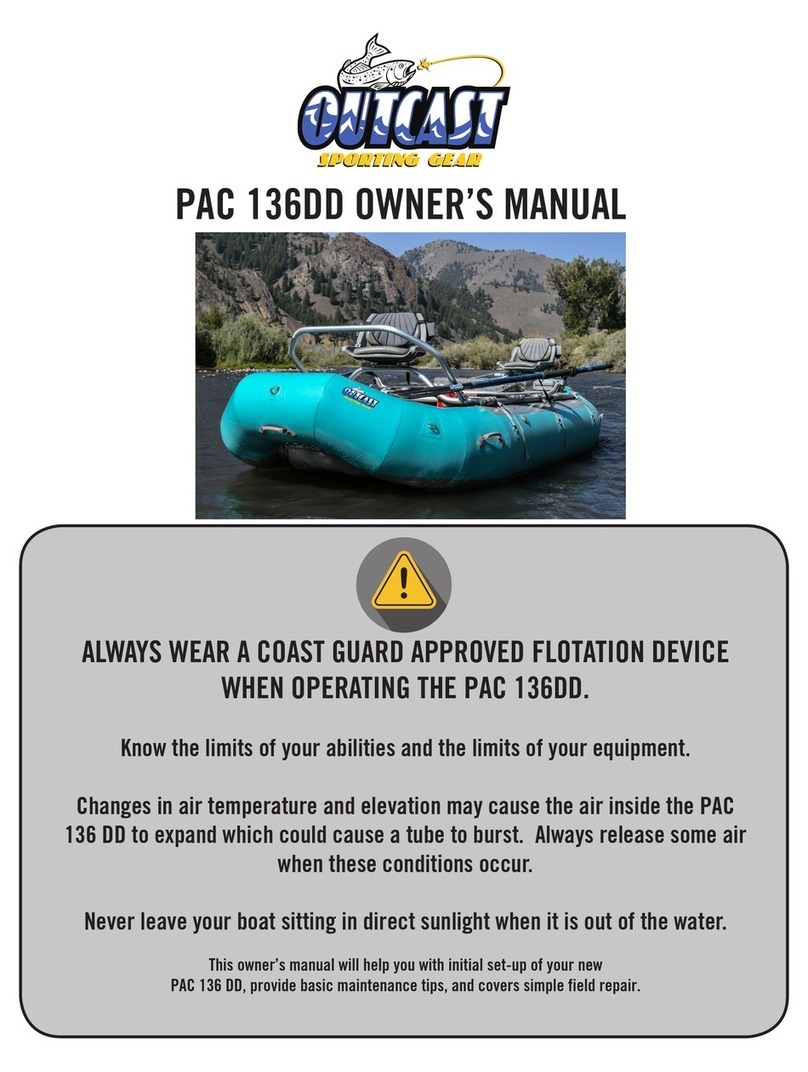
Outcast Sporting Gear
Outcast Sporting Gear PAC 136DD owner's manual
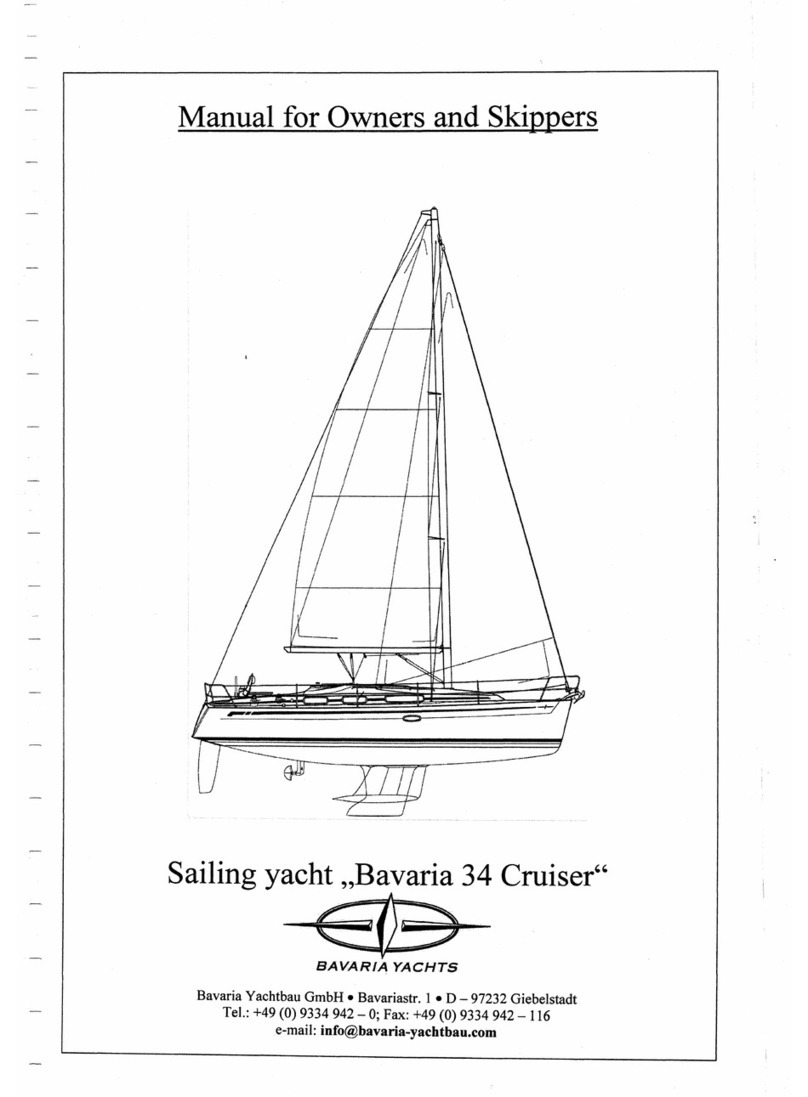
Bavaria Yachts
Bavaria Yachts 34 Cruiser Manual for owners and skippers

Sea Eagle Boats
Sea Eagle Boats Fishing Explorer 350fx Instruction & owner's manual

Bavaria
Bavaria 33 2008 Information & operation manual
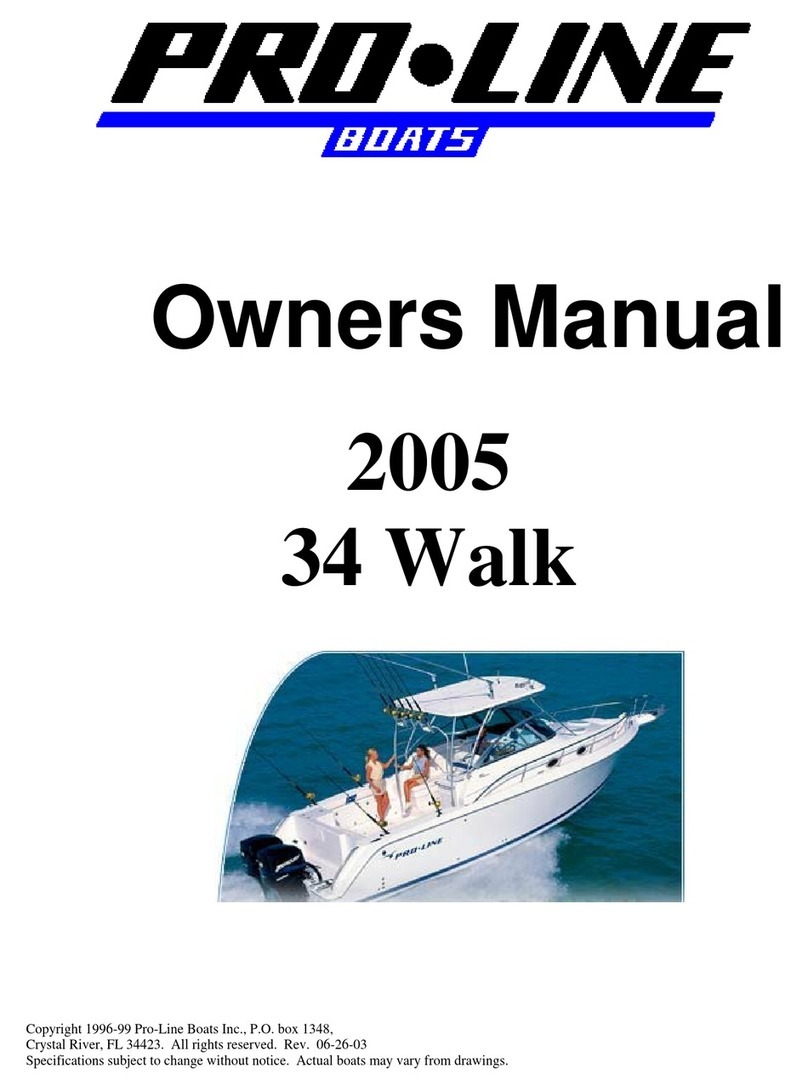
Pro-Line Boats
Pro-Line Boats 2005 34 Walk owner's manual
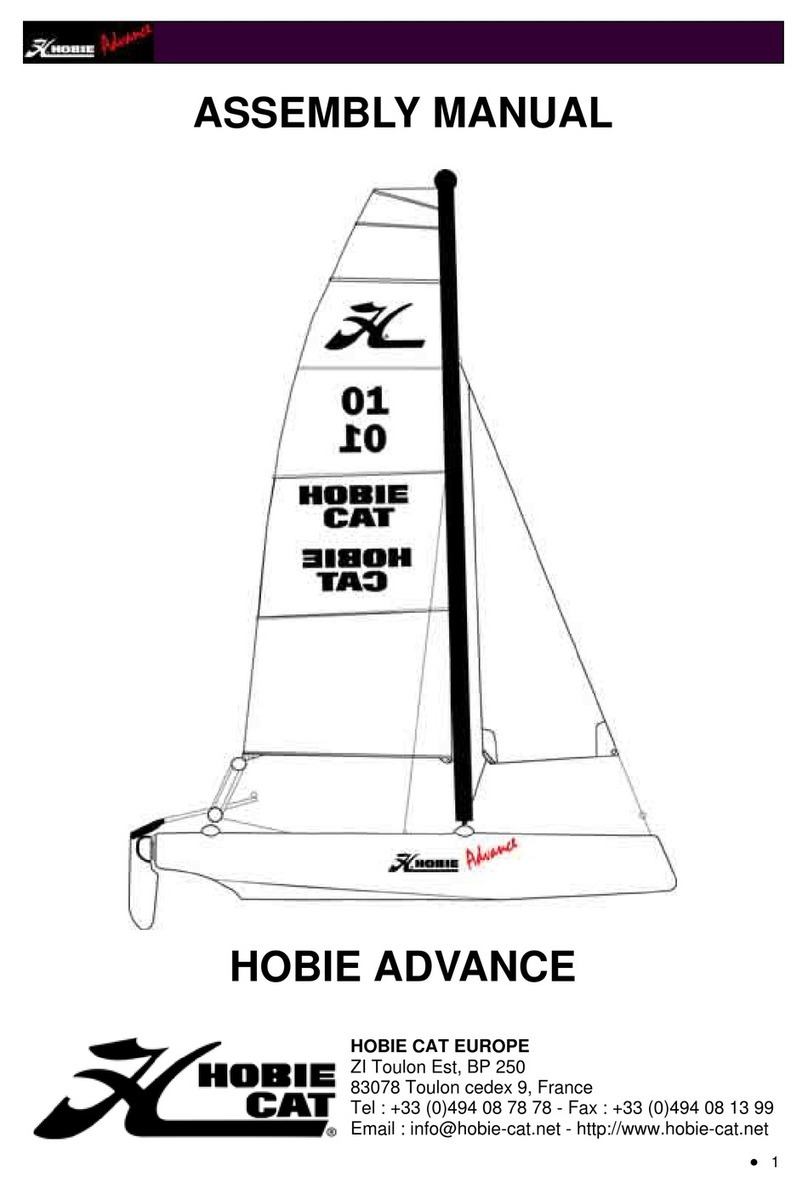
Hobie
Hobie ADVANCE Assembly manual


